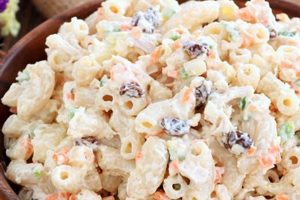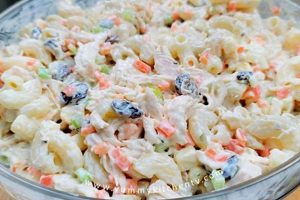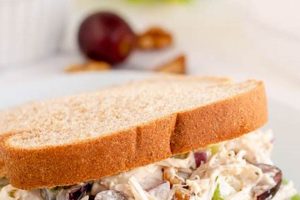Simple chicken salad sandwich preparations involve combining cooked chicken, mayonnaise, and seasonings. Common additions include celery, onion, grapes, or nuts. These recipes offer a quick and customizable meal option, ranging from basic combinations to more elaborate variations. For instance, a fundamental recipe might call for shredded chicken, mayonnaise, diced celery, salt, and pepper, all mixed together and served on bread.
Convenient and adaptable, these recipes provide a nutritious and satisfying meal. Their popularity stems from the ease of preparation and the wide availability of ingredients. Historically, chicken salad emerged as a way to utilize leftover cooked chicken, evolving from simple combinations to more complex and nuanced recipes over time. This adaptability makes it suitable for various dietary needs and preferences, as ingredients can be easily substituted or omitted.
The following sections will delve into specific ingredient combinations, preparation techniques, and tips for crafting the perfect quick and easy chicken salad sandwich. Variations for different dietary restrictions and preferences will also be explored. Finally, suggestions for serving and presentation will be provided to elevate this simple dish.
Tips for Easy Chicken Salad Sandwiches
Streamlining the preparation process for chicken salad sandwiches allows for a quick and delicious meal. These tips focus on maximizing efficiency and flavor without sacrificing quality.
Tip 1: Utilize pre-cooked chicken. Rotisserie chicken or pre-cooked chicken breast significantly reduces preparation time. This eliminates the need for cooking and shredding raw chicken.
Tip 2: Employ a food processor for chopping. A food processor efficiently chops celery and onions, ensuring a consistent texture and saving valuable time.
Tip 3: Customize the mayonnaise base. Greek yogurt or avocado can be incorporated into the mayonnaise to create a lighter, healthier alternative with unique flavor profiles.
Tip 4: Enhance flavor with simple additions. Fresh herbs, such as dill or chives, add a bright, fresh element. A dash of lemon juice or apple cider vinegar can provide a tangy kick.
Tip 5: Season thoughtfully. Salt and pepper are essential, but consider adding a pinch of paprika, garlic powder, or onion powder for depth of flavor.
Tip 6: Adjust textures strategically. Adding chopped nuts or grapes provides a satisfying crunch. For a smoother texture, finely dice all ingredients.
Tip 7: Chill before serving. Chilling the chicken salad allows the flavors to meld and creates a more refreshing sandwich.
Employing these tips ensures a flavorful and satisfying chicken salad sandwich experience with minimal effort. Attention to detail, even in simple recipes, elevates the final product.
By following these practical tips, preparing a delicious and easy chicken salad sandwich becomes a simple and enjoyable task. The next section will explore variations and serving suggestions to further enhance the experience.
1. Quick Preparation
Quick preparation is a defining characteristic of easy chicken salad sandwich recipes. The ability to assemble a satisfying meal within a limited timeframe contributes significantly to the popularity of this dish. This section explores the facets of quick preparation in the context of these recipes.
- Pre-cooked Ingredients
Utilizing pre-cooked chicken or readily available alternatives like canned tuna or chickpeas drastically reduces preparation time. Rotisserie chicken from a grocery store, for instance, eliminates the need for cooking and shredding, a significant time-saving step. This allows for a near-instant start to the recipe.
- Simplified Techniques
Easy chicken salad sandwich recipes typically involve straightforward techniques like chopping, mixing, and spreading. These actions require minimal culinary skill and contribute to the overall speed of preparation. For example, combining all ingredients in a single bowl streamlines the process.
- Minimal Equipment
Few specialized tools are required. A bowl, a fork or spoon for mixing, and a knife for chopping or spreading are generally sufficient. This accessibility further enhances the ease and speed of preparation. The lack of complex equipment contributes to the convenience of these recipes.
- Adaptable Ingredients
Common pantry staples and readily available produce often suffice. This minimizes shopping time and allows for substitutions based on available ingredients. Using ingredients already on hand contributes to the speed and convenience.
These facets of quick preparation demonstrate how easy chicken salad sandwich recipes prioritize efficiency without compromising flavor or satisfaction. The ability to create a complete meal with minimal time investment positions these recipes as an ideal choice for busy individuals or those seeking convenient meal solutions. This emphasis on speed and simplicity directly contributes to their broad appeal.
2. Simple Ingredients
The accessibility and ease of “chicken salad sandwich recipes easy” directly correlate with the simplicity of their ingredients. These recipes typically rely on common pantry staples and readily available produce, minimizing the need for specialized or hard-to-find components. This characteristic contributes significantly to their convenience and popularity. For instance, a basic chicken salad requires cooked chicken, mayonnaise, celery, onion, salt, and pepper ingredients typically found in most kitchens. This reliance on readily accessible ingredients allows for spontaneous preparation without extensive planning or shopping.
The focus on simple ingredients not only contributes to convenience but also offers significant advantages in terms of cost-effectiveness and adaptability. Using readily available ingredients often translates to a lower overall cost per serving compared to recipes requiring specialty items. Furthermore, simple ingredients offer flexibility for substitutions and customizations based on individual preferences or dietary needs. For example, Greek yogurt can replace mayonnaise for a lighter version, or grapes and nuts can be added for textural complexity. This inherent adaptability makes these recipes suitable for a wide range of individuals and situations.
In summary, the simplicity of ingredients plays a crucial role in the accessibility and adaptability of easy chicken salad sandwich recipes. This characteristic contributes to their cost-effectiveness, convenience, and broad appeal. By utilizing readily available components, these recipes empower individuals to create a satisfying and customizable meal with minimal effort and expense. This direct link between simple ingredients and ease of preparation underscores the practical value and enduring popularity of these recipes.
3. Versatile Flavors
The adaptability of chicken salad to a wide range of flavor profiles contributes significantly to the sustained popularity of easy chicken salad sandwich recipes. This versatility stems from the neutral base of chicken and mayonnaise, which readily accepts diverse flavor additions. This adaptability makes these recipes appealing to a broad audience with varying taste preferences.
- Classic Combinations
Traditional additions like celery, onion, and herbs such as dill or chives establish a familiar and comforting flavor profile. These classic combinations provide a reliable and predictable outcome, appealing to those seeking a traditional taste. For example, the subtle sharpness of onion complements the creamy mayonnaise and tender chicken, while celery adds a refreshing crunch.
- Sweet and Savory Contrasts
Incorporating sweet elements like grapes, dried cranberries, or apples introduces a contrasting dimension to the savory base. This interplay of sweet and savory notes adds complexity and interest. The sweetness of grapes, for example, balances the savory notes of the chicken and mayonnaise, creating a more nuanced flavor profile.
- Spicy Influences
Adding a touch of spice through ingredients like jalapeos, curry powder, or a dash of hot sauce introduces a kick, catering to those who prefer bolder flavors. A small amount of diced jalapeo, for instance, adds a noticeable heat without overpowering the other flavors.
- Textural Variations
Flavor versatility extends beyond seasonings and includes textural elements. Incorporating chopped nuts, such as walnuts or pecans, or water chestnuts introduces a satisfying crunch. This textural contrast enhances the overall sensory experience. The crispness of water chestnuts, for example, complements the softer textures of the chicken and mayonnaise.
This inherent flavor versatility, encompassing classic combinations, sweet and savory contrasts, spicy influences, and textural variations, positions easy chicken salad sandwich recipes as a highly adaptable and consistently satisfying meal option. The ability to effortlessly customize the flavor profile contributes to the enduring appeal of this simple yet versatile dish. This adaptability ensures that these recipes can be tailored to suit a wide array of individual preferences and palates.
4. Minimal Cooking
Minimal cooking is a defining characteristic of easy chicken salad sandwich recipes, directly contributing to their convenience and speed of preparation. The reliance on pre-cooked or minimally processed ingredients significantly reduces active cooking time, making these recipes ideal for quick meals. This characteristic distinguishes them from more elaborate sandwich preparations that require extensive cooking processes. For example, using rotisserie chicken eliminates the need to cook and shred chicken, a process that could add a significant amount of time to the overall preparation. Similarly, utilizing canned tuna or chickpeas further minimizes cooking requirements. This minimal cooking aspect broadens the appeal of these recipes to individuals with limited time or culinary experience.
The reduced cooking requirement translates to several practical advantages. It simplifies cleanup, as fewer pots and pans are used. It also reduces the overall energy consumption in the kitchen, contributing to energy efficiency. Furthermore, minimal cooking preserves the nutritional value of ingredients, as they are not subjected to prolonged heat exposure. For instance, using pre-cooked chicken retains its protein content without the potential nutrient loss associated with overcooking. This focus on minimal cooking aligns with contemporary lifestyle trends that prioritize convenience and efficiency in meal preparation. The ability to create a satisfying meal with minimal active cooking time positions these recipes as a practical and appealing option for busy individuals.
In summary, minimal cooking represents a key element of easy chicken salad sandwich recipes. This aspect enhances convenience, simplifies cleanup, promotes energy efficiency, and helps preserve nutritional value. By minimizing the need for active cooking, these recipes offer a practical and accessible approach to meal preparation, aligning with contemporary lifestyle demands for quick, healthy, and convenient meal solutions. This emphasis on minimal cooking underscores the practicality and enduring appeal of these recipes in the context of modern life.
5. Customizable Options
Customizability represents a significant advantage of easy chicken salad sandwich recipes, contributing to their broad appeal and adaptability to diverse dietary needs and preferences. This inherent flexibility allows for variations in ingredients, flavors, and presentation, transforming a simple base recipe into a personalized culinary experience. The following facets highlight the extensive customization possibilities within this seemingly simple dish.
- Dietary Adaptations
Easy chicken salad sandwich recipes readily accommodate various dietary restrictions. Substituting Greek yogurt or avocado for mayonnaise creates a lighter, lower-fat version. Omitting or substituting ingredients caters to specific allergies or intolerances. For example, individuals with gluten sensitivities can use gluten-free bread or lettuce wraps. This adaptability ensures inclusivity and broadens accessibility.
- Flavor Profiles
The neutral base of chicken and mayonnaise provides a blank canvas for flavor exploration. Incorporating curry powder creates an Indian-inspired twist, while adding grapes and pecans delivers a sweeter, more traditional profile. The addition of herbs, spices, or other flavoring agents allows for endless variations tailored to individual preferences. This flexibility empowers individuals to personalize their sandwich experience.
- Textural Elements
Customizing texture enhances the sensory experience. Adding chopped nuts or water chestnuts introduces a satisfying crunch, while finely dicing all ingredients creates a smoother consistency. These textural variations further personalize the dish, catering to individual preferences. The ability to manipulate texture adds another layer of customization to these recipes.
- Presentation Styles
Beyond the core ingredients, presentation offers additional opportunities for customization. Serving the chicken salad on croissants, crackers, or lettuce wraps provides alternatives to traditional bread. Garnishing with fresh herbs or a sprinkle of paprika elevates the visual appeal. These variations transform a simple sandwich into a more sophisticated presentation, suitable for different occasions.
The extensive customizability of easy chicken salad sandwich recipes extends beyond mere convenience. It empowers individuals to actively participate in the creation of a meal tailored precisely to their preferences and needs. This flexibility ensures that these recipes remain a versatile and satisfying option for a wide range of individuals and occasions, solidifying their position as a culinary staple. The capacity for customization transforms a simple dish into a personalized culinary expression.
6. Nutritious Meal
The nutritional value of a chicken salad sandwich hinges on ingredient selection and preparation methods. While “easy” often implies convenience, it doesn’t preclude nutritional value. Lean chicken breast provides a significant source of protein, essential for muscle building and repair. Thoughtful ingredient choices further enhance the nutritional profile. Incorporating vegetables like celery, onions, and bell peppers adds fiber, vitamins, and minerals. Utilizing whole-grain bread increases fiber intake, contributing to digestive health and satiety. Controlling mayonnaise quantity and opting for low-fat versions reduces overall fat and calorie content. For example, a chicken salad sandwich made with whole-grain bread, lean chicken breast, plenty of chopped vegetables, and a light dressing constitutes a balanced and nutritious meal. Conversely, a sandwich prepared with white bread, excessive mayonnaise, and limited vegetables offers less nutritional value.
The “easy” aspect of these recipes can contribute to positive dietary habits. Quick preparation time makes healthy eating more accessible, particularly for individuals with busy schedules. The customizability of chicken salad allows for adjustments tailored to specific dietary needs. Substituting Greek yogurt for mayonnaise reduces fat and increases protein. Incorporating nuts and seeds adds healthy fats and antioxidants. Individuals managing sodium intake can use low-sodium chicken broth and seasonings. This adaptability allows for a balanced, nutrient-rich meal tailored to individual requirements. For instance, a person managing their weight can create a lower-calorie version by using whole-wheat bread, skinless chicken breast, and light mayonnaise, supplemented with plenty of celery and other low-calorie vegetables. This demonstrates that “easy” does not necessitate compromising nutritional value.
The ability to create a nutritious meal through “chicken salad sandwich recipes easy” underscores the potential for convenience and healthy eating to coexist. Focusing on lean protein sources, incorporating nutrient-rich vegetables, and controlling less healthy additions like mayonnaise allows for a balanced and satisfying meal. This understanding empowers individuals to prioritize both convenience and nutritional value in their dietary choices. Addressing potential nutritional deficits through mindful ingredient selection and preparation methods ensures that these easy recipes contribute to overall well-being, rather than detracting from it. The practical significance of this understanding lies in its ability to guide individuals towards healthier choices within the context of convenient meal preparation.
Frequently Asked Questions
This section addresses common inquiries regarding easy chicken salad sandwich recipes, providing concise and informative responses to clarify potential uncertainties and enhance understanding of this versatile dish.
Question 1: What is the best way to prevent chicken salad from becoming watery?
Excess moisture in chicken salad often stems from high-water-content ingredients. Thoroughly draining canned chicken or patting dry cooked chicken before incorporating it into the salad minimizes excess moisture. Similarly, removing excess moisture from vegetables like celery and onions before adding them helps maintain the desired consistency. Using a thicker mayonnaise or incorporating a small amount of Greek yogurt also helps bind the ingredients and prevent a watery consistency.
Question 2: How long can chicken salad be stored in the refrigerator?
Properly stored chicken salad typically remains safe to consume for three to five days in the refrigerator. Storing the salad in an airtight container helps maintain freshness and prevents contamination. It is crucial to ensure the refrigerator temperature remains at or below 40F (4C) to inhibit bacterial growth.
Question 3: Can chicken salad be frozen?
While freezing chicken salad is possible, it is generally not recommended. Freezing alters the texture of the mayonnaise, often resulting in a separated and less desirable consistency upon thawing. If freezing is necessary, it’s advisable to freeze the chicken and other ingredients separately and combine them with mayonnaise after thawing.
Question 4: What are some healthy alternatives to mayonnaise in chicken salad?
Greek yogurt and mashed avocado offer healthier alternatives to mayonnaise, reducing fat and calorie content while adding nutritional value. These substitutes provide a creamy texture and a distinct flavor profile, offering a lighter and healthier twist on traditional chicken salad.
Question 5: How can one enhance the flavor of chicken salad beyond basic seasonings?
Fresh herbs, such as dill, chives, or parsley, add brightness and complexity. Incorporating spices like curry powder or paprika introduces depth and warmth. A touch of lemon juice or apple cider vinegar provides a tangy counterpoint to the richness of the mayonnaise. These additions elevate the flavor profile beyond basic salt and pepper.
Question 6: Beyond bread, what are some alternative ways to serve chicken salad?
Chicken salad offers versatility beyond traditional bread. Lettuce wraps provide a low-carbohydrate and gluten-free option. Serving the salad on crackers or croissants offers a different textural experience. Using the salad as a filling for bell peppers or tomatoes creates a visually appealing and refreshing presentation.
Understanding these frequently asked questions equips individuals with the knowledge necessary to create and enjoy easy chicken salad sandwiches with confidence and competence. Addressing common concerns regarding preparation, storage, and customization ensures a consistently satisfying experience.
The following section will offer a curated selection of easy chicken salad sandwich recipes, demonstrating practical applications of the information presented thus far.
Conclusion
Exploration of “chicken salad sandwich recipes easy” reveals the confluence of convenience, nutrition, and adaptability. Minimal cooking requirements, readily available ingredients, and diverse flavor customization options position these recipes as practical and versatile meal solutions. The capacity to accommodate various dietary needs and preferences through ingredient substitutions and flavor adjustments further amplifies their appeal. Efficient preparation techniques, utilizing pre-cooked components and streamlined processes, minimize time investment without compromising flavor or nutritional value.
The enduring popularity of these recipes reflects their adaptability to contemporary lifestyles. As culinary preferences evolve, the capacity for customization within this simple framework ensures continued relevance. Emphasis on fresh, wholesome ingredients and mindful preparation techniques elevates “chicken salad sandwich recipes easy” beyond mere convenience food, positioning them as a viable component of a balanced and satisfying dietary approach.






